 |
|
 | 2.
The Fabulous DC-10 Pt 1 The Americas The Douglas DC-10, created to a large degree to meet a request from American Airlines first flew in August of 1970. American launched DC-10 operations in August of 1971 between Chicago and Los Angeles, beating the much delayed competing L-1011.
Despite being clobbered by some tragic crashes, and accompanying brutal press, the DC-10 proved to be a rugged and effective airliner with a few of the 446 aircraft still operating.
Following are postcards featuring DC-10s operated by various American operators |
| 405 Visits
126 Images
Shared Album | |
|
 | 3.
Remembering Trans Brasil July 2024 Sadia was formed with the acquisition of a DC-3 in 1954, principally to transport products of the company "Industria e Comercio Concordia" from Concordia to Sao Paulo. By 1956 the airline was officially launched with 35 employees , 3 DC-3s and 2 C-46's. By 1962, with the aid of some acquisitions Sadia served 53 Cities.
The year 1967 saw the arrival of five Handley Page Heralds, and by 1970 the BAC-11-500 was added to the fleet.
As the scope of the airline had been greatly expanded, the Airline became Trans Brasil in 1972. By 1983 international operations were launched with 767s, and Trans Brasil became the 2nd largest airline in Brazil.
As the airline grew, so did its debts, and the fleet was grounded in 2001, never to return to service. Following are postcards from this once great Brazilian airline |
| 616 Visits
53 Images
Shared Album | |
|
 | 4.
Canadian Pacific in Postcards June 2024 At the end of WW II, airlines were springing up like dandelions, spurred on by the availability of surplus C-47s, and the rapidly growing travel market. The Canadian Pacific Railroad had begun air service in 1942, by acquiring a number of small "bush" operators in western Canada, and by 1945 was expanding with C-47 equipment. But in 1949 Canadian Pacific was awarded rights to serve Australia and the Far East , which prompted the acquisition of 4 Argonaut aircraft, or as Canadian Pacific described them "North Stars". While Government owned Trans Canada was protected, Canadian Pacific pioneered new international services, including the first polar routes to Europe.
CP Air was acquired by Pacific Western in 1987, forming Canadian Airlines, which ultimately was acquired by Air Canada. Following are cards illustrating the diverse fleet of the airline that became "Canadian" |
| 653 Visits
61 Images
Shared Album | |
|
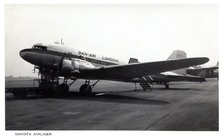 | 5.
Remembering Dan Air May, 2024 Dan Air, a subsidiary of the Davies And Newman shipping, was formed in 1953, in actuality taking over operations of the small airline Meredith Air Transport. Charter operations began at Southend, but by 1960, moved to Gatwick. Expanding its charter flights and initiating scheduled services.
Growth in services resulted in a Comet 4 fleet by 1966, later adding 707s 727s BAC 111s and in 1983 launching the BAE-146 into commercial service.
The airline set up a base at Berlin's Tegel airport in 1969, and growth and innovation expanded at an amazing pace. However, as much of its space, including scheduled services was sold to consolidators and travel agencies yields were simply insufficient to support the vast operations. The airline was ultimately sold (essentially given to) British.
There is a splendid well illustrated history of Dan Air, on simpleflying.com, titled What Happened to Dan Air. Well worth viewing |
| 794 Visits
47 Images
Shared Album | |
|
 | 6.
A Postcard history of Ansett. April 2024 Launched in 1936, Ansett Airways established a niche with budget fare interstate operations, avoiding direct conflict with Australian National and Trans Australia. It was in October of 1957 that Ansett acquired the struggling Australian National Airways, and became Ansett ANA.
Ansett thrived through years of competition with TAA, expanding often through acquisition of smaller airlines.
The airline prospered through the early 1980s. but Australian deregulation in the early 1990s opened the door for new growth or failure. Ultimately acquired by Air New Zealand, the airline struggled with maintenance issues and new competition. Ansett was essentially abandoned by Air New Zealand in 2001, stranding thousands, and putting 16,000 employees out of work.Following are cards from Ansett, and a number of operators incorporated into the airline through the years. |
| 1698 Visits
108 Images
Shared Album | |
|
 | 7.
The SE-210 Caravelle Part 1 Air France | After the introduction of the Comet, at the request of the French Comite' du Materiel Civil a number of designs for a medium range advanced airliner were proposed. The successful offering was submitted by SNCASE, which resulted in an order for construction of two prototype aircraft in July of 1953. The significance of this order was to be realized as the twin Avon powered Caravelle was a sensation in service, followed by similar offerings by Douglas, British Aircraft and Tupolev. Following are cards featuring the prototypes, and images of the Caravelle in Air France livery. Many thanks to Kuo Ching Fu for sharing his comprehensive assembly of Air France versions. |
| 364 Visits
49 Images
Shared Album | |
|
 | 8.
Remembering the IL-62 Feb. 2024 Undoubtably the most beautiful of the Soviet airliners and perhaps most successful was the Ilyushin IL-62, which entered service in 1967.
Production ended with 292 aircraft constructed. Following are a number of postcard views of this graceful airliner. Thanks to Paul Roza for sharing a number of these images |
| 1767 Visits
148 Images
Shared Album | |
|
 | 9.
The Route of The Stars Jan 2024 | National Airlines was incorporated in 1937 in St. Petersburg Florida. Although originally serving only Florida destinations, its growth was rapid, and by 1944, National inaugurated Miami-New York Non stop flights with DC-4 aircraft. Under the leadership of L. B. Maytag, National became a leader in a number of areas; 1st domestic jet flights, first all jet airline, pioneering the southern trans-continental route, and Florida to Europe non stops. The disastrous acquisition by Pan Am led to the end of this once great airline. Following is a little postcard history of National Airlines |
| 1048 Visits
60 Images
Shared Album | |
|
 | 10.
Remembering Mexicana 12/ 2023 | It was in August of 1924 that Compania Mexicana de Aviacion was born, using two Lincoln Standard bi-planes to connect Mexico City with Tampico and Matamoros. By 1925, service began to Brownsville, Tx. and growth and innovation continued through various ownerships until its sad collapse in 2010. Following is a little postcard history of Mexicana |
| 890 Visits
42 Images
Shared Album | |
|
 | 11.
Postcard treasures from Japan Nov 2023 Although seldom seen in the United States, many outstanding airliner cards were issued by Japanese publishers. Kuo-Ching Fu has kindly shared a number of examples from his outstanding collection. First in the set below are cards from a lucky number promotion by Meiji Seika Kaisa Ltd. of Japan. A monthly drawing for prizes was held, which could be claimed by sending in the attached winning numbered tab. Other cards are designated as from Crown, unidentified blank back, and 2 from Tokyo International Airport.
Mario Romano DaSilva has also shared some outstanding Japanese Airport issues and NBC issues, designated with MDS suffix |
| 918 Visits
58 Images
Shared Album | |
|
 | 12.
Revisiting the Jaeger Cards. 10/23 | Four years ago Jaeger Cards from Geneva were the subject of the month. There have been a number of additions since then, shared by Kuo Ching Fu. These are the currently known Jaeger Issues. The duplicate numbers are, in fact, correct. I would very much appreciate scans of any not included, and of course would credit the sender. |
| 1234 Visits
76 Images
Shared Album | |
|
 | 13.
The Golden Falcons of Gulf Air 9/23 | Gulf Aviation began as a sightseeing service by British Aviator Freddy Bosworth, operating an Avro Anson. The growth in oil company charters led to the aquisition of a DeHavilland Dove in 1951, and later scheduled services between cities with a Heron. By 1968 F-27s entered service, with a particular focus on quality cabin service. BOAC had acquired controlling interest in the company in 1951, but in 1973 the four Arab governments acquired the company. The growth was rapid based on flourishing oil economies, and a clear emphasis on premium service that continues today. Following are cards illustrating their fleet development through the years. Many thanks to Kuo-Ching Fu for sharing the beautiful recent issues. |
| 883 Visits
55 Images
Shared Album | |
|
 | 14.
The "Mystery" (Peter Black) issues 8/23 | In November 2018, I posted several unidentified (at the time) numbered cards shared by Kuo-Ching Fu. They were later identified as Peter Black issues, but they have remained incredibly elusive. I have only a single card from the series. Kuo Ching has recently shared some additional cards from the series, so we are updating the previous page. If there are fellow collectors who have some of the many missing cards, scans of those would be very much appreciated, and of course credited. In my view this set would be the most priceless of the vintage collector sets published. |
| 850 Visits
24 Images
Shared Album | |
|
 | 15.
A Look at Southwest Airlines July 2023 | Southwest Airlines took off, so to speak, in 1971, as an intra-state carrier, connecting Dallas, Houston and San Antonio. From the start, there was a focus on making flights an entertaining experience, and to say the least, the concept was well received. Deregulation opened the door to expansion beyond Texas in 1979, and the growth was phenomenal, aided by the acquisition of other airlines. Following are postcard views of Southwest's 737s, plus some of the airlines integrated into Southwest. |
| 1277 Visits
38 Images
Shared Album | |
|
 | 16.
Remembering the Pocket Rocket (BAC-111) | The enormous success and passenger appeal of the early jets quickly spurred action on jet aircraft for short haul and lower capacities. By 1961 the newly consolidated British Aircraft corporation launched the BAC-111 with orders from British United, soon to be followed by Braniff and Mohawk in the US. A total of 244 One Elevens were built, serving all over the world. Following are cards illustrating many of the 111 operators. |
| 5043 Visits
229 Images
Shared Album | |
|
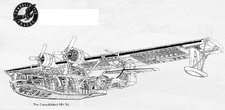 | 17.
Amphibious Airliners. May, 2023 Early international air travel had many obstacles to overcome, such as range limitations, and lack of airports and fueling facilities. As early as 1929, the development of "flying boats" enabled flights to be undertaken to previously inaccessible destinations. In 1931 Pan Am launched services to the Carbbean, Central and South America with the Sikorsky S-40. Larger and more capable aircraft soon followed, and prior to WWII, amphibians served much of international travel.
On the other hand lack of airport facilities and remote locations in smaller markets often required amphibious aircraft, which particularly suited the Catalina and Grumman's amphibious aircraft.
Some postcard illustrations of these transformative aircraft follow below |
| 3801 Visits
163 Images
Shared Album | |
|
 | 18.
California's Airlines. April 2023 | California, a state larger than many countries, has always had a demand for rapid intra state transportation. In fact the first scheduled passenger airline in the US, Chaplin Airlines, was formed in 1919 to ferry passengers to Catalina Island. Through the years, a substantial number of airlines have evolved, unfettered by CAB regulations and requirements. Many operated briefly and disappeared, others became major airlines which escaped the confines of California. Following is a postcard view of some of these California operators. |
| 1526 Visits
81 Images
Shared Album | |
|
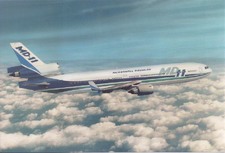 | 19.
The Last of the Great Douglas Airliners Douglas Airliners from the DC-2 through the DC-10 had a history of superior performance and longevity. The DC-8 and DC-9 airframes were later modified with great success extending their utility for many years. Given those previous successes, it's not surprising that an advanced and upgraded DC-10 would be contemplated. And so it was that in 1986, the advanced DC-10, redesignated as the MD-11, was launched. By the end of 1990, the first MD-11s were in service with Finnair.
But the facts were that the beautiful aircraft did not quite meet its performance goals in range and payload. Ultimately some launch orders were cancelled, and sales were relegated to some 200 units. Nevertheless, the airliner has served for more than 30 years, and is continuing to serve as a cargo airliner. Following are a number of postcard views of this beautiful aircraft. Thanks to Terry Hale, Kuo-Ching Fu and PK Chai for sharing a number of these images. |
| 2179 Visits
153 Images
Shared Album | |
|
 | 20.
The Evolution of Icelandair Feb. 2023 The Island nation of Iceland, has, by necessity, had a reliance on air transportation, given the isolation of the island, and rugged terrain within. Although some air services existed in the 1920s, Icelandair was essentially launched in 1940 as Flugfelag Islands, with a Waco YKS 7. In two years Beech 18, DeHavilland Dragon, and a PBY Catalina joined the fleet, international service began in 1945 with flights to Scotland.
Loftleidir was formed as a domestic competitor in 1944, but as conditions evolved , Loftleidir focused on international services, ultimately becoming the low cost "Backpacker's Trans Atlantic Airline. Inevitably, merger occurred in 1973, and Icelandair successfully transitioned into the major international airline of today. Following are postcards illustrating that progression. |
| 2133 Visits
98 Images
Shared Album | |
|
 | 21.
A look at Ethiopian Airlines 1/ 2023 Formed by Proclamation of Emperor Haile Sellassie in 1946, Ethiopian Airlines has been the most successful of the National Airlines from the African Continent. Launched with a fleet of 5 DC-3s, and navigating through some turbulant times, Ethiopian has remained the leader in service and technology to the present.
Following are postcards that illustrate the years of growth and innovation |
| 1604 Visits
57 Images
Shared Album | |
|
 |
|
 | 23.
The GREAT silver Fleet. Pt 1. Nov. 2022 In the course of our history no airline has been more celebrated and yet more maligned than Eastern. Born in 1930 after operating as Pitcairn Aviation for several years, Eastern began to grow to near dominance in the Eastern states under the management of Eddie Rickenbacker. Pioneering new services and aircraft Rickenbacker steered the airline through the war years and emerged as the predominant airline in the Eastern United States. In later years major competition evolved, earnings became more difficult, and labor issues continued to plague the airline until its financial decline ended in 1991 after being acquired by Frank Lorenzo's Holding Company. The sight of Eastern's Grounded fleet was heart breaking, to say the least.
Following are postcard images of this great airline in it's most prosperous days. |
| 1891 Visits
116 Images
Shared Album | |
|
 | 24.
The National Airlines of Central America | The Countries of Central America each had airlines which beside their commercial necessity were an item of national pride. In years of spotting at Miami, one of the highlights was the arrival of inbound flights from the Central American countries. Some have disappeared and others have pursued bolder ambitions, but their histories and accomplishments are indelible. Some of the postcard histories are quite modest, and others rather expansive. Following are examples from those exceptional airlines |
| 1641 Visits
99 Images
Shared Album | |
|
 | 25.
A Look at Aerolineas Argentinas 9/2022 | After the end of World War II, air transportation in Argentina began to develop domestically, and the need for international transportation was realized. It was in 1946 that Flota Aerea Mercante Argentina was launched which began to connect Argentina with Europe, and ultimately with the USA. Despite some political resistance to using American aircraft, post war C-54s were available and practical, ultimately numbering 12 in service. Two new Avro Yorks were added to the fleet. The plan was to add the new Avro Tudors as well, but the aircraft were never accepted. By 1949 the government merged F A M A with three domestic entities to create a national airline, that would be Aerolineas Argentinas. Though stubbornly unprofitable, Aerolineas Argentinas has been a pioneering, progressive intercontinental airline since 1950. |
| 1662 Visits
66 Images
Shared Album | |
|
 | 26.
Remembering the Handley Page Herald 8/22 The long search for "the DC-3 Replacement" had a lot of candidates. Some programs were enormously successful, others, not so much. While Convair was rolling out hundreds of new twin engine airliners, Handley Page's Reading facility was, as often seen with British manufacturers, focusing on an aircraft optimized for primitive airfields. The result was the high wing Herald, equipped with four Alvis Leonides Major piston engines. Unfortunately, the reliability and economics of the Dart Turbine obsoleted the Herald by the time it first flew in August, 1955. In 1957 the piston prototypes were successfully re-equipped with Dart turbines, and the result was a rugged viable airliner, which had already been hammered by the Fokker designed F-27. Fifty of the Dart Heralds were produced, which established a very solid record of service.
Following are some postcard examples of this somewhat too late player in the DC-3 replacement contest. |
| 1523 Visits
47 Images
Shared Album | |
|
 | 27.
Philippine Airlines. July 2022 In February of 1941 Philippine Airlines was formed to replace PATCO. (Philippine Air Transport Co.) Operations began on March 15, 1941, With Beech 18 aircraft operating from Manila to Baguio and return. After interruption by the war, Philippine really began to fill its mission, providing transportation to and from the remote parts of the Islands, while connecting the Philippines with the World.
Following is a brief postcard history of this great airline. |
| 1521 Visits
67 Images
Shared Album | |
|
 |
|
 | 29.
Taiwan's intercontinental Airline 4 /22 China Airlines was formed in December 1959 with two PBY Catalinas operating charter flights. It was October of 1962, when the airline operated its first scheduled service from Taipei to Hualien. In September of 1966 China acquired an Ex Trans International 1049H Constellation to launch international services from Taipei to Saigon.
As a government owned entity, in 1967, China was simply allowed to replace the well known and highly respected Civil Air Transport on international routes in Asia. These were facilitated with new 727 aircraft
Boeing 707s were acquired to initiate Trans Pacific Services, and despite a history of safety related issues, the airline has evolved and become a significant global airline.
Following are postcard images illustrating the evolution of China Airlines from domestic start up to Global giant. |
| 1789 Visits
109 Images
Shared Album | |
|
 | 30.
The Regional Airlines of Taiwan Mar 2022 The Republic of China or Taiwan emerged from World II, and the Communist takeover of the Mainland to become a free and prosperous nation, which has spawned a number of great airlines, large and small.
Following are examples of the rich airline history of Taiwan, excluding the global airlines China and Eva, which will be addressed at a future time.
The story begins with Civil Air Transport whose mission served both security interests, and commercial travel. Following are glimpses of a number of innovative airlines that followed. |
| 2096 Visits
87 Images
Shared Album | |
|
 | 31.
Aer Lingus. February 2022 | No airline is more a reflection of their homeland than Aer Lingus. Founded in 1936, with a single DeHavilland Dragon, connecting Dublin and Bristol, Aer Lingus has grown, rather conservatively into the International airline it is in 2022. Following is a little history of Aer Lingus in Postcards, preceded by some publicity items. |
| 2987 Visits
87 Images
Shared Album | |
|
 | 32.
Rare and Collectible pt 5. Jan. 2022 | This month features another collection of airline issues which have proven to be elusive. Thanks once more to Kuo-Ching Fu for sharing a number of these gems. |
| 1132 Visits
41 Images
Shared Album | |
|
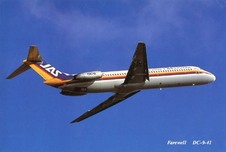 | 33.
Japan Air System December 2021 On April 1, 1988, TDA officially was renamed Japan Air System. A week later, the first DC-10-30 aircraft was delivered, and by July 1, the first international segment (Tokyo-Seoul) was operated. Routes soon stretched to Singapore and Hawaii, using the newly delivered DC-10s.
Japan Air System's history of excellence in technology and service continued until the ultimate merger with Japan Airlines in 2004. Following are a selection of cards illustrating the Japan Air System Fleet. |
| 2320 Visits
84 Images
Shared Album | |
|
 | 34.
Toa Airways, and its descendants 11/21 Toa Airways was created in November of 1953, operating their first flight in February 1954. By November of 1956 2 Beech C18S aircraft were delivered to perform flights to off shore islands. Subsequently, in 1961, 2 De Havilland Dove and several De Havilland Herons joined the fleet, serving Ryuku, Kyushu, Honshu, Chugoku and Shikoku. In 1962, their first Convair 240s were acquired, followed in 1965 with a fleet of new YS-11s.
In 1971 Toa merged with Japan Domestic Airlines to form Toa Domestic (TDA). Japan Domestic had been created in 1964 by a merger of North Japan, Fuji, and Nitto Aviation. The newly formed TDA rapidly grew into a major airline, operating a modern jet fleet which ultimately included the A-300 in 1980.
Following are postcards of some of the aircraft leading up to Toa Domestic, and the creation of Japan Air System. |
| 1389 Visits
39 Images
Shared Album | |
|
 | 35.
Remembering Alitalia October, 2021 The year was 1946 when Aerolinee Italiane Internazionali was formed, Launched with Italian built airliners, the first flights took place in 1947. By 1948, The airline spread its wings across the Atlantic, using Avro 691 Lancastrian aircraft. The 36 hour flight left Rome, stopping at Dakar, Natal, Rio de Janeiro, Sao Paulo, and Buenos Aires. The airline experienced modest growth until 1957, when a merger was accomplished with L A I, Italy’s other international airline.
From that beginning Alitalia grew into one of the great intercontinental airlines covering most of the world with state of the art airliners. Sadly, that will end on October 14, and Alitalia will join Pan American, TWA, Sabena and Swissair in the graveyard of airline icons.
Following are cards illustrating Alitalia’s airliners, and those of its affiliates. They will be missed. |
| 2526 Visits
151 Images
Shared Album | |
|
 | 36.
The Airlines of Pakistan Sept. 2021 The populous and rugged lands of Pakistan have from their inception relied on air transportation. At the time of partition from India, Orient Airways was operating from Calcutta to Rangoon. Afterwards it was relocated to Karachi, and provided essential services connecting centers in west and East Pakistan. In 1955 it became part of newly formed Pakistan International Airlines.
For decades, PIA has remained a successful and up to date international airline. The airline also has a legacy of high quality postcards, many of which are quite collectible.
Included below are a selection of PIA cards, plus the airline of the former East Pakistan. (Biman Bangladesh). Also included are some cards from Private Airlines that have operated in Pakistan. |
| 1674 Visits
67 Images
Shared Album | |
|
 | 37.
Collecting the rare ones pt. 4 | A final group of cards, that aren't very easy to find. Most of these have drawn a fair amount of interest through the years. |
| 1449 Visits
40 Images
Shared Album | |
|
 |
|
 |
|
 | 40.
Collecting the Rare Ones Pt. 1 May 2021 What makes a card really collectible? Certainly, scarcity is reflected in price, as we've seen card prices exceed $1000.00. Card printings have varied from multiple issues of 250,000 to 1000 or less. It seems that particularly valuable are limited printings from the major airlines, but issues from smaller obscure airlines are equally appealing to me.
There is no doubt that values and degree of collectability are subjective, and that these examples don't begin to include all of the priceless cards that have been issued over time. But following are some of my most valued, and some kindly shared by other collectors. |
| 1912 Visits
79 Images
Shared Album | |
|
 | 41.
DeHavilland’s Pioneering Commuters 4/21 Near the conclusion of WWII, DeHavilland began development of a replacement for the successful pre-war Dragon Rapide. That ultimately resulted in the twin engine all metal monoplane design of the Dove. Carrying 8-11 passengers the Dove sold 544 aircraft from 1946-1967. Engine upgrades and after market aerodynamic improvements helped extend the life of the Dove.
The success of the DH-104 Dove led to the development of a larger airliner, which used many components designed for the Dove. By May of 1950 the Heron took flight, using four Gypsy Queen 30 engines for power, and , strangely a fixed undercarriage. As time passed these inadequacies were remedied, and the Heron enjoyed a long service life, most notably with the Riley Aircraft modifications, but also with a more radical turboprop upgrade by Saunders.
Finally, DeHavilland of Australia developed a three engine derivative of the Dove christened the Drover, which may have set the standard for failed aircraft programs. Following are some postcard views of these remarkable airliners. |
| 2830 Visits
68 Images
Shared Album | |
|
 | 42.
Alia The Royal Jordanian Airline The present day Royal Jordanian Airlines was created in 1963 by decree of King Hussein. The initial fleet was comprised of 2 Handley Page Heralds and a DC-7. Since that time and through some turbulent periods, the airline has prospered and grown into a truly global airline.
The focus on adequate and up to date equipment has been reflected through the years in the airline's postcard history, although recent issues have at times been puzzling.
Following are selected cards illustrating the evolution of Alia, Royal Jordanian's fleet. Included are issues from subsidiary operations undertaken by the airline. |
| 1872 Visits
61 Images
Shared Album | |
|
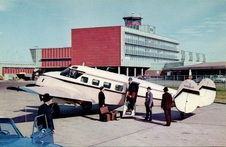 | 43.
A Look at Corporate Airliners March 2021 Essentially beginning in the 1950s, the "company plane" became an essential piece of equipment. Without the limitations of railroad or airline schedules, a company plane sped management, operations, and sales personnel to meetings and job sites with maximum efficiency. As time went on the plane became a significant marketing tool as well, useful in transporting customers to job sites as well as recreational sites.
War surplus aircraft were an affordable early option, with ex military Beech 18s being a popular favorite.
As industries grew, the scope of aircraft operations grew as well, resulting in a range of aircraft from single engine Cessnas to 747s.
Beechcraft was early in recognizing the potential of "company planes", and quickly directed their marketing to that arena. Following are postcards featuring Corporate Airliners, including some early Manufacturer issued cards. |
| 1990 Visits
67 Images
Shared Album | |
|
 | 44.
Remembering Air Afrique February 2021 Air Afrique was the creation of a great Pan African airline, supported by and serving 11 newly independent African Nations. These nations with equity and support from Air France and UAT, launched the new airline in 1961. Remarkably the early years showed growth and promise, as the airline served French West Africa, later expanding to Europe and North America.
The airline operated a diverse fleet, often relying on short term leases of various aircraft to supplement their fleet.
However, politicization and mismanagement gradually took their toll on the airline, and after 41 years this proud emblem of the African continent became history.
Following are postcards featuring some of the beautiful airliners that served Air Afrique. |
| 1310 Visits
26 Images
Shared Album | |
|
 | 45.
The Ultimate STOL DHC-7 January 2021 DeHavilland of Canada had a unique history with STOL aircraft. The Beavers and Otters served inaccessible destinations primarily in Canada and Alaska, with wheels, skis and floats. By 1964, the demand existed for a larger updated aircraft, resulting in the enormously successful DHC-6 Twin Otter. The Twin Otter's role expanded far beyond the uniquely northern missions of its predecessors, and DeHavilland put nearly 1000 to work serving Commuter Airlines around the world.
A decade later, The DHC-7 was born, an actual airliner, with the exceptional STOL performance of earlier models. Though demand for such an aircraft was limited, the DHC-7 filled its role in many diverse environments, which ultimately led to the more practical and successful DHC-8 series.
Following are some postcard views of this remarkable airliner. |
| 3410 Visits
61 Images
Shared Album | |
|
 | 46.
A Postcard History of Hawaiian Airlines | Created in 1929, Inter-Island Airways was an unlikely candidate to become a 21st century intercontinental airline. But, step by step, the airline prospered, and recovered from financial setbacks. Hawaiian was a leader in new aircraft implementation from the DC-3 days to the present, and once unleashed by deregulation, gradually created a huge network focused on its unique destination. Following are cards and some photos illustrating that history. |
| 2888 Visits
76 Images
Shared Album | |
|
 | 47.
Remembering Sabena Pt 2. Nov. 2020 It was October of 1958 when the original 707 began service on the North Atlantic. Just 1 year
later, Sabena took delivery of their first of the new Intercontinental 707-329s, making world travel a far more practical undertaking. Sabena remained a leader in aircraft technology unti the sad end in 2001. Part 2 will feature Sabena's jet fleet in postcards. |
| 2726 Visits
114 Images
Shared Album | |
|
 | 48.
Remembering Sabena pt 1 Oct. 2020 The year 1923 saw the creation of Sabena It's modest beginning with a flight from Brussels to London was soon to be amplified by a need for air service in the Belgian Congo. By 1931, Sabena was operating 43 aircraft, and by 1935, the first scheduled flights were undertaken from Belgium to the Congo. Even during WW II Sabena maintained services to Africa. The post war years saw Sabena grow into "Belgian World Airlines", a leader in both service and technology.
But the 1990s were unkind to Sabena, and proliferating competition took a toll that even a Swissair management group couldn't fix. The Sept 11, attack's effect on travel was the final blow, and Sabena was liquidated in November 2001. The airline left a legacy of excellence that can't be replaced. |
| 3773 Visits
130 Images
Shared Album | |
|
 | 49.
LOT 90 years and counting Sept 2020 LOT ( Polskie Linie Lotnicze ), was created in December of 1928, executing its first flight on January 1st 1929. Initially flying Junkers and Fokker aircraft, LOT was quick to introduce new aircraft, taking delivery of the DC-2 in 1935 and the L-10 Electra in 1936. After the disruption of the war, LOT was reestablished, with a fleet of LI-2s, and DC-3s, connecting Poland with nearby European capitals. In 1947, the airline acquired a short lived Languedoc fleet, but afterwards, new aircraft acquired were the necessarily Russian built aircraft. LOT was able to acquire some Convairs and Viscounts on the used market during that time.
In the 1960s and 70s, LOT expanded across the Atlantic and as far as Bangkok to the east, but the government crackdown in the early 1980s severely inhibited the airline's growth.
After the fall of communism in Poland, LOT quickly resumed its growth and innovation, becoming the modern international airline that it is today.
LOT's postcard history is also impressive from the early DC-2s to the current 787s. Following are cards illustrating most of the 90 + years of LOT. |
| 5121 Visits
243 Images
Shared Album | |
|
 | 50.
The Fairchild Turboprops August 2020 The chase for a DC-3 replacement went on for 2 decades, with manufacturers from various countries searching for the right combination of economics and performance. Fokker's efforts began in 1952 and soon produced concepts for the Friendship airliner. On November 24, 1955 the prototype Friendship took flight.
With an eye toward penetrating the US market, a licensing agreement was reached with Fairchild in 1956 for the production of the aircraft in the Americas. The first Fairchild built F-27 entered service in July of 1958 even preceding the first Fokker built aircraft, later that year.
The rest is history, so to speak, as F-27s from both manufacturers filled the air. Some 582 Fokkers were built along with 209 Fairchilds. As time passed second hand Fairchilds were acquired in countries around the world.
Following are postcards of Fairchilds displaying first the new builds, and following those, the aftermarket acquisitions for both the F-27, and the FH-227 models. |
| 3656 Visits
83 Images
Shared Album | |
|
 | 51.
The Elegant Vickers VC-10 July, 2020 Universally acclaimed as the most beautiful of the early jet airliners, and clearly a passenger favorite, the VC-10 entered service from London to Lagos in April of 1964.
Unfortunately, the aircraft was another victim of the frequently disfunctional British aircraft development process, a constantly evolving proposed mission that resulted in the airliner being introduced long after competitors had captured most of the market. Like other British airliners, hot and high performance was superior, but operating economics were not. Ultimately only 55 of the model 1100 and 1150 models were assembled, with the final VC-10 1154 delivered to East African in February 1970.
Nevertheless, the airliner's impact was substantial, and popularity with passengers unmatched.
Following are a number of postcard views of the swift and silent VC-10. |
| 2448 Visits
93 Images
Shared Album | |
|
 | 52.
Remembering Varig 1927-2006 In May of 1927, VARIG was established in Porto Alegre, operating it's first flight with the Dornier "Atlantico" from Porto Alegre to Rio Grande on June 22 of that year. The airline gradually expanded with Junker F-13s, A-50s and an F-52, as well as a Dehavilland Dragon Rapide. It later standardized on the more modern Lockheed L-10 Electra in the latter 1930s.
After the outbreak of WW II, the airline under the leadership of Ruben Martin Berta, began a period of continued growth and acquisition that lead to flights to the USA in 1955, the acquisition of REAL in 1961, and Panair Do Brasil in 1965.
Control of Cruzeiro was attained in 1975, and Varig was Brazil's airline to the world.
But political changes and deregulation in the 1990s started a decline in the fortunes of the once dominant Brazilian airline, which gradually led to its sad break up, sale and ultimate final demise in 2006.
The greatest of South American airlines is gone, but a very nice postcard history remains, as shared below. |
| 2800 Visits
116 Images
Shared Album | |
|
 | 53.
Remembering South African Airways The year was 1929, when Union Airways was formed, much like other pioneer airlines, as a mail carrier. By 1934 passenger services had been undertaken, but the airline was in distress. The South African government took over the operation, adding Southwest Airways a year later, forming the South African Airways which operated until 1940.
Following the war, service was restarted with a fleet of Lockheed Lodestars, and soon thereafter, the Avro York was temporarily used to provide an air service to England. By 1946, DC-4s were introduced, and the airline emerged as a modern international airline.
A long history of excellence and professionalism followed, both domestically and internationally. But the political revolution that ended apartheid also gradually impacted the operations of South African, and today we most likely are about to witness the end of this great airline.
Following is a post card history of South African Airways. |
| 4353 Visits
155 Images
Gallery Album | |
|
 | 54.
A Selection of Korean Air Cards 4-2020 After the end of World War II, Korean National was organized, serving Seoul and Pusan with Stinson Votagers.. It was subsequently shut down during the Korean war, but emerged in 1952 with a fleet of DC-3s and DC-4s.
It was developing into an international airline when in 1962, it was acquired by the government, and reappeared as the Korean Air of today. After a somewhat turbulent history with some crashes and two airliners shot down, Korean Air has become one of the major world airlines.
For most of that time the airline has been generous with Postcards. Following is a selection of Korean airline issues. |
| 3832 Visits
69 Images
Shared Album | |
|
 | 55.
The Vickers Vanguard. March, 2020 The comfortable and powerful Vickers Vanguard was the honored guest that arrived after the party was over. After the Viscount's successful production, there was interest in more powerful and larger mid range aircraft, which could be used on shorter existing runways. Lockheed's offering, tailored to the requests of Eastern and American received launching orders in 1955, and rather quickly completed 129 sales. It entered service in January 1959.
The Vanguard, matching BEA's specifications, would enter service almost 2 years later. By this time, the Electra tragedies had occurred, and the public's appetite for Propeller driven aircraft was waning. Only 44 Vanguards were sold to BEA and Trans Canada.
Unfortunate, as the Vanguard performed very well, and operated through the mid 1990s.
Following are some postcard views of this airliner that arrived a little too late. |
| 1904 Visits
32 Images
Shared Album | |
|
 | 56.
Post Deregulation startups The controversial Airline Deregulation Act of 1978, forever altered the landscape of American aviation. The legacy airlines, often rather bloated, had to deal with emerging new competition, inevitably at lower costs. New airlines emerged and often disappeared just as quickly under the pressure of powerful frequent flyer programs and mega hubs. As is usually the case, the better conceived and managed survived. Unfortunately, most did not. But the new opportunities brought innovation and lower prices to the marketplace, as the legislation intended.
Following are some of the airlines that were launched into the post de-regulation arena. |
| 3018 Visits
130 Images
Shared Album | |
|
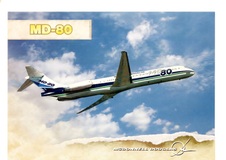 | 57.
Celebrating the Super 80 jan. 2020 Douglas built tough airliners. From DC-3s to DC-8s, the Douglas airliners were rugged and reliable. The DC-9, introduced in 1965 was no exception, with original models from 1966 still operating today.
By 1979 the little DC-9 had been stretched and updated 3 times, but then Douglas launched an extraordinary stretch equipped with Pratt & Whitney JT8D-217s. This was to become the DC-9 "Super 80", the most successful and popular of all DC-9s. Almost 1200 of the sleek Super 80s found homes with airlines from Start ups to the Giants.
But, as we enter the year 2020, the Super 80 has become a relic, as emphasized by the final flight of American's once huge MD 80 fleet.
The time seems appropriate for a postcard review of the many operators of this extraordinary airliner. |
| 5216 Visits
198 Images
Shared Album | |
|
 | 58.
Remembering Northeast December 2019 Northeast Airlines was actually created by two railroads, expanding into the airline business. Boston & Maine Airways, founded in 1931, and Central Vermont Airways, formed in 1933, served New England routes which were operated under contract by National Airways, a company which, incidentally, was created by a group including Amelia Earhart.
The combined airlines were renamed Northeast in November 1940, operating DC-3s and L-10 Electras through New England as well as Montreal, Halifax and Charlottetown in Canada.
Northeast actually originated the Air Shuttle between Boston and New York in 1946 using DC-4s on the hour.
The year 1956 saw the inauguration of their first flights to Washington DC and Florida using newly acquired DC-6s, but despite its success, Northeast had to struggle to keep that authority for a number of years. Later route strengthening efforts failed, even including a short lived southern trans continental route in 1969.
A brief fling with Howard Hughes in control from 1962 to 1964 bore little fruit, and by 1965 the airline was acquired by Storer Broadcasting. It was then that the airline launched its bold and appealing "Yellowbirds", which really elevated the airline's perception in the marketplace, but couldn't fully cure Northeast's chronic lack of profitability. The airline, however, was a perfect fit for Delta, which was essentially absent from the Northeast.
In 1972 the successful merger with Delta brought an end to the Yellowbirds, but those bright yellow and white airliners will always be a pleasant memory.
Following are some postcard views of Northeast's aircraft from 1940 through 1972. |
| 2002 Visits
50 Images
Shared Album | |
|
 | 59.
Boeing's mighty mini, The 747 SP 11/2019 After the successful introduction of the Boeing 747, and the consequent growth in international traffic, there evolved a demand for a longer range aircraft, to some degree a political demand for an aircraft to fly non stop to more distant capitals, ie. new York to Tehran.
Simultaneously, Douglas and Lockheed were exploiting the huge gap in capacity between the 707s and 747s, a market that Boeing was forfeiting.
Ultimately, a judgement was made that a reduced size 747 could fill both of those roles. With some refinements to vertical and horizontal stabilizers, plus a modified shorter fuselage, the SP was born with launch orders from Pan Am and Iran Air.
Boeing's engineers were correct in that the SP opened new horizons of non stop flight, but they were completely wrong that such an aircraft could compete with the tri engine competitors.
By the early 1980s longer range 747 200Bs could match the range of the SP, thus the small niche occupied by the SP was eliminated.
Only 45 SPs were built,but for a few short years the SP was the crown Jewell of the industry.
Following are some postcard views of the ground breaking 747SP. |
| 7250 Visits
76 Images
Shared Album | |
|
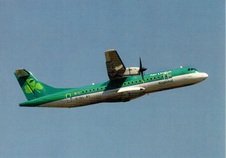 | 60.
The ATRs Part 2, October 2019 | The ATR-42 was, indeed a hit, but the 72 model was a home run, with well over 1000 in service, and production continuing, albeit at a modest pace. The cards following reflect the broad assortment of operators that are flying or have flown the 72. |
| 9063 Visits
111 Images
Shared Album | |
|
 | 61.
The ATRS Part 1 Sept. 2019 They're not very pretty. They sort of remind one of an updated Handley Page Herald. The announcement of the new European built commuter aircraft in 1981 barely evoked a yawn. The combination of Aerospatiale and Aeritalia had never built nor marketed an airliner.
By the time of the announcement, 713 F-27s had been built, and the updated F-50 model was forthcoming. DeHavilland of Canada had announced the DHC-8, a versatile derivative of the DHC-7 that would be available in a number of sizes. It wouldn't appear to be the best market opportunity for a fledgling company.
But, by August of 1984 the first ATR-42 took to the air. Aircraft #5 entered service with Cimber Air in December 1985. Other European regionals also gave it a shot, and to the surprise of many, The ATR-42 delivered. So much so that 1545 of the unassuming turboprops and the derivative 72 models were delivered to operators, both large and small. Most are still in service today.
Following are postcard images of some of the many ATR-42s |
| 6645 Visits
121 Images
Shared Album | |
|
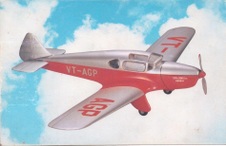 | 62.
A Postcard History of Air India 8/2019 Air transportation in India began much the same as in the United States. Contracts were awarded to carry mail, which rather quickly followed with the transportation of adventurous passengers. In 1932, Mr. J. R. D. Tata began serving an air mail route from Karachi to Bombay and Madras. In the process of carrying 10.7 tons of mail 155 passengers were also transported.
In 1938 the airline became Tata Air Services operating a 6 seat Miles Merlin. By 1948 the newly independent government acquired a 49%
interest in the airline, and it became Air India. The year 1953 saw the creation of Indian Airways to handle domestic services, leaving Air India to be the International entity, similar to England's designation of BEA and BOAC. It was 2011 before the airlines were unified into the great airline known as Air India. Following are postcards illustrating the aircraft from 1948 to the present. |
| 6456 Visits
87 Images
Shared Album | |
|
 | 63.
The Accidental Airliner July 2019 An enormously successful Commuter Airliner program was certainly not the objective when Ed Swearingen first mated a new pressurized fuselage to Beech Queen Air wings, and twin Bonanza landing gear. The result was the SA26 Merlin. Its original Lycoming Engines were quickly replaced by P&W PT6s, and shortly thereafter, Garrett TPE 331s, to create the Merlin IIs. The Merlin IIs were essentially seen as competitors to the King Air 90, and 87 of the IIs were built.
In 1972 the Merlin III was introduced with new wings, nacelles and landing gear. This model was ultimately stretched to create the Merlin IV, and the Metro commuter liner version. Although initial sales were mostly for the Merlin IV, it's not entirely fair to refer to the airliner as an accident. More accurately an unexpectedly favorable development. The Metro simply clobbered the Beech 99 and Twin Otters that were in service at the time with speed and pressurization.
The development costs had depleted Swearingen 's funds, resulting in a buyout by Fairchild, which was better equipped to develop the airliner sales as well as corporate market.
The rest as they say, is history with over 600 metros sold, serving airlines world wide. Following are cards of Metroliners, and a few of its predecessors. |
| 5810 Visits
62 Images
Shared Album | |
|
 | 64.
1933, Birth Of The Modern Airliner 6/19 The year 1933 was the beginning of the airliner revolution that put an end to the wood and fabric contraptions that previously carried daring passengers on frequently harrowing flights.
Boeing led the way in Feb. 1933 with the 247, a huge technological advancement, but inadvertently created their own competition by reserving the first 60 for United Airlines, leaving TWA and others, out in the cold.
TWA then solicited proposals for a comparable aircraft, which was very successfully met by Donald Douglas. The DC-1, essentially a prototype, was airborne by July 1933, and went into service with TWA on Sept 15, 1933. Production of the DC-2 began with an order for 20 from TWA.
Lockheed's L-10 Electra was flying by February 1934, and shortly thereafter entered service with Northwest. It also introduced the twin tail concept, soon to be adopted by the very successful Beech 18 as well as future Lockheed offerings.
In the end, Boeing's refusal to share production resulted in the sale of 198 DC-2s, and 149 L-10s, leaving only 15 additional 247s for Boeing.
Improvements and derivatives came quickly, but these three airliners essentially launched the industry. Following are some postcard views of these pioneers. |
| 8754 Visits
105 Images
Shared Album | |
|
 | 65.
The Jaeger Airliner Cards May 2019 While the USA had few vintage airline postcard publishers, Europe had a diverse group of publishers producing excellent cards from the 1950s to the present. Among the very early publishers was Editions Jaeger of Geneva Switzerland. Long a publisher of scenery and monument cards, Jaeger began issuing cards of airliners and the Geneva airport around 1950. The earliest cards appear to be airliners superimposed on scenes of Lake Geneva. But soon thereafter Jaeger began to issue excellent in flight images, apparently sourced from the airlines or the manufacturers. This continued until the early 1960s.
Jaeger backs were not very informative, but some slight evolution occurred during the 10 years of publication. Several backs are illustrated which are not necessarily in chronological order.
A reborn Jaeger appeared around 1965, but apparently did not focus on airliners.
Once again Kuo Ching Fu has shared many of these cards from his personal collection (indicated by the KCF suffix) They are very much appreciated. |
| 4967 Visits
67 Images
Shared Album | |
|
 | 66.
Remembering Northwest April 2019 Northwest Orient, a name that described the powerful and prosperous Minnesota Airline that grew into a major global airline from a 1926 Air mail contract. The first passenger was carried in 1927. By 1928 the airline was flying Trimotors and extending service toward the west.
By 1934, the airline had reached Seattle, and Northwest took delivery of the first Lockheed 10A Electra. The year 1939 brought the DC-3 to Northwest, and, in the post war years Northwest was a leader in route development and aircraft introduction. By late 1947 Northwest DC-4s were flying the "Northwest Passage" to Tokyo. Some 40 years later the first 747-400s were introduced. Ultimately, in 1986 Northwest nearly doubled in size with the acquisition of Republic Airlines
The growth continued until the early 2000s when a number of factors led major airlines into bankruptcy.
Afterwards, as the US airlines continued to coalesce, Northwest was finally absorbed in a colossal merger with Delta. In 2010 this great and innovative airline ceased to exist. |
| 15298 Visits
140 Images
Shared Album | |
|
 | 67.
Enell & Hoff Airliner Cards Mar 2019 As vintage publisher cards go, the early 1950s Enell series is among the most collectible. An excellent biography of George Enell by Tadd Kotick, as well as an illustrated list, may be found on Larry Myers Postcard Post.
I've attempted to update the list, and provide images of the cards below. Cards of subjects other than airliners are omitted. The first image, is from a series of Enell photos that correspond to the postcards. Since the photos aren't numbered, I'm only speculating that this view might be the elusive card #3.
Prior to the Enell issues, in the 1940s, Official LaGuardia Airport photographer William Hoff issued a series of cards related to the airport. There were a number of reissues, in slightly different formats, and like the Enells, photo sets were sold including 12 airport or airliner views for $.25. I've included photos where I'm missing cards. This set which follows the Enell cards, is incomplete.
Naturally, I would very much appreciate scans of missing cards. |
| 7851 Visits
78 Images
Shared Album | |
|
 | 68.
Airliners Nobody Wanted part 2 Feb 2019 Boeing, since the advent of the 707, has been pretty consistent in the success of their offerings. But along the way there have been the occasional bust when airliners simply did not attract buyers. Most of these have been successful in service despite their low numbers.
But then there was the 737-600. To the casual observer it was just another 500 without a winglet option and a much higher price tag. While obviously a serviceable aircraft, the airliner is comparatively inefficient.
Others that didn't sell, such as the 737-100, 757-300, and 767-400, have distinguished themselves with excellent service despite their paltry numbers. It's hard to believe only 55 757-300s were sold. No 767-400 and few 757-300s have been unloaded by their original buyers.
Douglas had their own models that drew no interest as well, such as the DC-9-20 and 40 models.
Following is a postcard review of these unwanted airliners. |
| 11511 Visits
87 Images
Shared Album | |
|
 | 69.
Airliners nobody wanted part 1 Jan/2019 Some airliners just don't work out. In the 21st century Boeing and Airbus are fully attuned to the demands of the marketplace, and carefully select projects to meet those demands. Yet, somehow both geared up to produce airliners nobody wanted. Of the comparatively few aircraft that actually sold, some were being scrapped at the ripe age of 3 or 4 years old. The A-318, the final shrinkage of the A-320, managed to sell 80 aircraft before buyers were scrapping them for the value of their components.
Failures were certainly not unprecedented. The long range A-340-200 and 500 models flamed out quickly, selling 28 and 37 respectively despite substantial promotion. In earlier years when marketing was less sophisticated some real bombs were produced. The Mercure and VFW-614 spring to mind as totally ignored offerings.
Following are some postcard memories of these unfortunate airliners. |
| 12817 Visits
92 Images
Gallery Album | |
|
 | 70.
The Revolutionary Caravelle 12 / 2018 In 1953, SNCASE, was awarded a contract to develop 2 prototypes of their proposed short to medium range jet powered aircraft. Capitalizing on DeHavilland's experience developing the Comets, the proven Rolls Royce Avon engine, and a fortuitous market segment selection, the project developed smoothly, and by 1955 the first prototype took flight.
The first orders were received in 1956. By April 1959 the tail mounted twin engine design entered service. While Boeing, Douglas, and DeHavilland battled over long haul jet orders, the Caravelle was unchallenged, and sold some 280 aircraft world wide.
The sleek Caravelle breathed life into the struggling French civil aircraft industry, and in fact helped to launch the Concorde years later.
Following are examples from most Caravelle operators, followed by a collection of assorted Caravelle cards. |
| 33771 Visits
245 Images
Shared Album | |
|
 | 71.
Mystery cards, a numbered set 11/18 I've always liked numbered sets, sort of like baseball cards. But for some reason I never acquired any of these unidentified, numbered black and white airliner cards until recently.
I know of no one who is aware of the publisher of these cards, but would very much like to have any information about them . Of course, scans of any others not shown would be particularly appreciated.
For now Kuo Ching Fu has generously shared a number of examples to add to my solitary Standard Airlines card.
Hopefully some one can solve the mystery!
Nov. 15, 2018. It has been confirmed that these are Peter Black issues. |
| 3779 Visits
16 Images
Shared Album | |
|
 | 72.
Remembering Capital Airlines 10/18 It is still hard for me to think of Capital in the past tense. The story of Capital's rise and fall is thoroughly documented in George Cearly's excellent 1988 publication. But no book can fully convey the sense of pride felt as Capital led America into the jet age, or the sense of loss as Capital struggled to remain viable in its latter years.
Capital successfully strengthened its system with new southern routes in the 50s , and clobbered their competition with the Viscounts, but a devastating series of crashes in the late 50s and persistant financial problems damaged their prospects, and stifled their recovery.
Capital aggressively tried to maintain its technological leadership with a Comet 4 purchase in 1956, but it failed to materialize due to delays and finances. Britannias and Electras were built for Capital, but financial issues never allowed their delivery. Finally an order for 7 Convair 880s was cancelled with the announcement of the merger with United.
Capital was gone, but the distinctive sound of those Rolls Royce Darts were heard for years to come, ghosts of Capital flying in United colors. Following are cards and photos, something of a scrapbook of Capital's evolution from 1930s to 1960s. |
| 11476 Visits
54 Images
Shared Album | |
|
 | 73.
The Turboprop Convairs 9 / 2018 By 1959, twin engined turboprop aircraft were entering the market, which effectively would obsolete the Convair twins. Meanwhile D Napier and son of England equipped and obtained certification for an Eland powered Convair which was designated the 540. This aircraft was leased to Allegheny for in service evaluation.
Later, Canadair acquired the rights to produce the Convair, including 3 unsold 440s with the intent of producing the Eland equipped 540s in Canada. Thirteen were built, ten of which went to the RCAF, and two were sold to Quebecair.
While the Eland powered Convairs were less than successful, the concept resulted in two very successful re-engining programs using Rolls Royce and Allison engines. Fifty years later Convair turboprops are still flying. |
| 41852 Visits
67 Images
Shared Album | |
|
 | 74.
Vintage Convair Props 8 / 2018 On March 16, 1947 the Convair 240 pressurized twin engine airliner first flew. Designed to fulfill a requirement from American Airlines to replace their DC-3s, the 240 essentially obsoleted the competing Martin 202, and succeeding models dominated the twin engine market. The rugged Convair designs were literally reborn as turbine aircraft in the 1960s, and some are still operating today.
Following is a selection of vintage cards showing many of the early Convair operators. |
| 29719 Visits
165 Images
Shared Album | |
|
 | 75.
The Embraer Jets July 2018 The ERJs, first conceived in 1989, and ultimately flying by 1995, were an unlikely major aircraft program from the Brazilian company which was launched with the creation of the EMB 110 Bandeirante in 1965.
The succeeding EMB120 was a completely new design, successfully competing with the Saabs, and operating with major airline affiliates in many countries.
But the first pure jet, begun with a stretch of the 120 fuselage, and evolving through 3 different engine configurations became a mainstay of the world commuter jet fleets.
That success led to the launching of the all new E-Jet family which entered production in 2002, and continues with over 1400 built.
All in all, an incredible success story for the once fledgling Brazilian industry. Following are cards showing a nice selection of ERJ operators.
Many thanks to Kuo-Ching Fu for sharing his comprehensive collection of ERJ cards. |
| 17568 Visits
99 Images
Shared Album | |
|
 | 76.
Flying Colors - Braniff Airways 6 / 2018 Paul Revere Braniff started his airline from Oklahoma City to Tulsa in 1928. Like many start ups it was a family undertaking and a struggle until their first mail contract in 1934. In 1935 the Lockeed L-10 Electra was added. Bowen Airlines was acquired in 1936, DC-2s in 1937 and DC-3s in 1939.
Braniff survived the war years, and launched services to South America in 1946. By 1952 Mid Continent was added and Braniff was established as a major airline. Everything was normal and profitable until 1965 when Harding Lawrence was appointed President.
It was Lawrence that ended the "plain plane" and grew Braniff in all directions. The rest as they say, is history. |
| 16043 Visits
80 Images
Shared Album | |
|
 | 77.
The Amazing Comets May 2018 In 1945 the first jet airliner was conceived. DeHavilland undertook the enormous task of developing, and delivering a revolutionary airliner that was ultimately to transform air travel in little more than a decade. On July 27, 1949 a prototype took to the air. By May of 1952 the Comet 1 was in service from London to Johannesburg.
The succeeding events are well known, but step by step the Comet design was refined to its final iteration, the sleek Comet 4s. The airliner was first (barely) on the North Atlantic, and introduced jet service over most of the world.
Following are cards showing the Comets that led the way, and by overcoming many technical issues, facilitated the rapid introduction of Jet airliners world wide. |
| 24427 Visits
94 Images
Shared Album | |
|
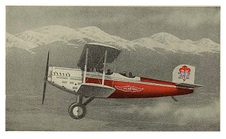 | 78.
60 years of Western airlines, April 2018 Launched as a mail carrier with Douglas M-2s, Western pioneered the air route from Los Angeles to Salt Lake City on April 26, 1926. Occasional passengers were carried among the mail sacks until 1928, when the Fokker F-10 arrived, with an enclosed cabin for the benefit of those daring initial passengers.
Western grew, acquiring Pacific Marine Airways, West Coast Air Transport and Standard Airlines by 1930. The depression was on, and the Postmaster General decided to merge Transcontinental Air transport with Western to create TWA. Only the original route remained to be operated by Western.
In 1934, Western divested itself of interest in TWA, creating a relationship with United which lasted for nearly a decade. After 1941, Western grew and prospered until the final merger with Delta in 1987. The oldest airline in America was no more. |
| 14521 Visits
68 Images
Shared Album | |
|
 | 79.
Remembering TWA Mar. 2018 How I miss TWA. Created in 1930 by the merger of Western Air Express and Transcontinental Air Transport it ultimately became Trans World Airlines. TWA pioneered "Skysleeper flights across the US, "Jetstream" Constellations on the polar route to Europe as well as the 1st trans-continental 747s. TWA became the first all jet American airline, and dominated Trans Atlantic travel for decades.
During those years TWA was afflicted by corporate predators Howard Hughes and Carl Icahn, but continued to reaffirm its position until a sequence of events which included the loss of a Trans Atlantic 747, and the invasion of TWA's St. Louis hub by Southwest necessitated a final bankruptcy and sale.
Sadly, the 21st century brought an end and after 75 years TWA was merged into American. |
| 19064 Visits
100 Images
Shared Album | |
|
 | 80.
A Look at Alaskan Airliners 2 / 2018 More than anywhere in the US, the 49th state depended on air transportation. Beginning in the late 20s daring bush pilots operated in demanding conditions to serve the needs of Alaskans. By 1935 Pacific Alaska was formed as a subsidiary of Pan Am, operating Lockheed Electras on a route from Juneau to Fairbanks. Shortly thereafter Alaska Star, soon to become Alaska Airlines was formed, and by 1938 Pan Am began operating to Alaska from Seattle. Pan Am incorporated Pacific Alaska in 1941, operating Lockheed Lodestars and DC-3s. Other airlines grew from bush operators to scheduled airlines in the following decades, and a new bush industry has evolved providing fishing, sightseeing, and other tourism services.
All the great names are gone, and Alaska has grown into a major Transcontinental airline, but aviation is as important as ever in the 49th state.
Following are the postcards I have of airliners that frequented the skies of Alaska. Also included are airline issues from many of the modern "bush" airlines supporting the tourism industry, provided by courtesy of Kuo-Ching Fu. |
| 23752 Visits
109 Images
Shared Album | |
|
 | 81.
Remembering the Avro/HS 748 1/2018 In the late 1950s, the DC-3 replacement contest was still underway. Fokker's F-27 was near introduction, including planned US production by Fairchild. By the time Avro launched, the F-27 was clearly in the pilot's seat (so to speak).
After first considering a similar design, Avro opted instead for a low wing aircraft designed to serve a niche market, specifically developing world markets where short field performance and self sufficiency were at a premium.
While the approach was self limiting to a degree, the 748 proved to be exactly as advertised, even resulting in its operation into Chicago's tiny Meigs Field. Ultimately the aircraft found broad acceptance in a wide variety of roles. Some 380 were produced, and operations continue in 2018.
Following are postcard views of this rugged and practical airliner. Also added are cards of its less than successful derivative, the ATP. |
| 19363 Visits
89 Images
Shared Album | |
|
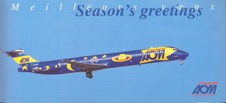 | 82.
Christmas & New Years Cards 12 / 2017 The Christmas season brings many treasures both tangible and intangible. Occasionally airlines join in by issuing cards for the holidays, and these are the few that I have, with kind additions from Hubert Jansen, and Terry Hale.
In addition to these, Kuo-Ching Fu has shared his amazing collection of Airline Holiday cards for all to enjoy.
Here's hoping this Christmas brings blessings of peace for all and the New Year brings good fortune as well as many postcard treasures! |
| 38676 Visits
232 Images
Shared Album | |
|
 | 83.
Stratocruiser, Queen of the props 11-17 In 1945, the C-97 freighter, derived from the WWII B-29, took flight. The heavy freighter, and later tanker, served the military for decades, with over 800 built.
A civilian adaptation was developed by 1947, and 50 aircraft were authorized for production without benefit of any orders. Given the failure of the Stratoliner, it was a bold move.
However, Pan American promptly ordered 20, introducing the airliner in April, 1949. Although a maintenance headache, the luxurious Stratocruiser was a serious competitive advantage, in effect forcing United and American to match the airliner on competitive routes.
The Stratocruiser became the emblem of Pan Am's world-wide dominance in the 1950s, and, though homely by comparison to the sleek Constellations and DC-6s, it has remained the symbol of that elegant and exciting period of air travel. |
| 14400 Visits
68 Images
Shared Album | |
|
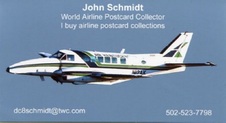 | 84.
The Commuters, pt 2 Oct 2017 As local service airlines became large Regional airlines the need for commuter replacements continued and many more airlines appeared in the 70s.
Ultimately, however, code sharing arrangements undeniably worked for the consumer. An independent could not successfully compete against a Major airline affiliated company. Code sharing could be a bonanza for a commuter, but loss of a code share usually was a death sentence. Independents slowly strangled and one by one, the great commuter industry disappeared.
Throughout the country are airports that once had scheduled airline service, but now handle only private aircraft. It would seem that a 70 mile drive down an interstate is a poor substitute for local air service, but that is frequently the case. |
| 30770 Visits
99 Images
Shared Album | |
|
 | 85.
The Rise of the Commuters Oct. 2017 The air taxis, later to be designated as "Commuters" began to appear in the early 1950s, offering basic transportation in unserved or underserved markets. They grew as certificated airlines sought to eliminate unprofitable segments, and in markets where frequency trumped comfort. Certainly by 1970 Commuters were a growing component of the air transportation system.
Following are cards of Commuters formed before 1970 that survived regulatory uncertainties, and often bad publicity to provide reliable air service to small markets. |
| 16708 Visits
92 Images
Shared Album | |
|
 | 86.
The Star-Crossed Martin Airliners 9 / 17 By 1946 the race was on for a DC-3 replacement. Convair and Martin both had twin engine proposals on the table. Martin promised an earlier delivery, albeit an unpressurised airliner. The pressurized 240 offering was approximately a year behind. Pennsylvania Central had ordered 50 of the proposed Martin 202 "Executives" and Colonial added 20 to the order book. Northwest, TWA and even LAN Chile added to an order book totaling 270 Martin aircraft. But by 1947, certification delays and an economic downturn dissolved the order book. Only Northwest, and later TWA among American Trunk airlines took delivery of 202s.
Adding to the collapse in confidence were numerous operational issues including structural failures and unexplained loss of control of several Northwest aircraft. Ultimately Northwest pilots refused to fly the aircraft, resulting in its removal from service in 1951. Only 46 202s were delivered.
Nevertheless Martin aggressively marketed the improved 404 version, even claiming that the model would be suitable for conversion to jets. Only Eastern and TWA took the bait, along with two for the Coast Guard. A total of 103 404s were built as Convair's rugged, reliable 240s and340s racked up over 1000 orders.
The Martin production quietly died, but second hand Martins fared reasonably well, operating into the 1970s.
Only a few airline issued Martin cards were produced, but following are all of the postcard views of Martins I have acquired. |
| 9937 Visits
46 Images
Shared Album | |
|
 | 87.
The Vickers Issued Postcards. 8 / 2017 Vickers Aircraft enjoyed some success with the Viking, but the Viscount revolutionized air travel. Alone in the marketplace for turbine powered airliners, Vickers capitalized on the success stories of Viscount operators, and marketed them in many ways including postcards. Postcard advertisements extolled the accomplishments both real and projected of the Viscount and later the Vanguard.
The Vickers airliner cards were beautifully presented, with excellent images of the aircraft, and frequently a success story on the back.
Following are the few I have been able to collect, accompanied by a number of remarkable contributions by Kuo-Ching Fu.
First listed are the early art cards featuring some of the earliest purchasers. Then the later 1950s issues with identification on the bottom.
Included are 2 data cards which are presumed to be Vickers Issue, and a sampling of Vickers post card advertisements.
Finally, there are several Airline Issues prepared by Vickers. Additions to any of these categories would be much appreciated! |
| 12677 Visits
76 Images
Shared Album | |
|
 | 88.
The Convair Jets 7 / 2017 There was nothing like the thrill of watching one of the Convairs departing with a massive cloud of black smoke slowly dissipating in its wake. The sleek Convair jets were the fastest of the new American jetliners, but never really found the niche that they hoped to occupy. Quickly obsoleted by more efficient tri jets, the 880s disappeared from their original buyers fleets, and never really had any significant secondary operators. The 990s lived on for some time with some upgrades, but they too are now a distant memory.
Following are cards featuring the fabulous Convair Jets! |
| 24438 Visits
110 Images
Shared Album | |
|
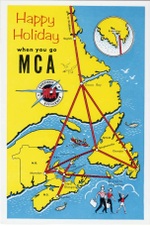 | 89.
The Canadian Regionals 6 / 2017 Far more than the US, rural Canada needed air transportation. Numerous independent and government operated entities filled this need using an assortment of bush aircraft. From this fragmented group several airlines coalesced and with the aid of growing populations, charter opportunities, and DEW Line contracts, grew into entities resembling the CAB designated Local Service Airlines in the US.
Ultimately 6 were designated as "Regional" Airlines by the Canadian Government, providing service to smaller communities and feeding the 2 major scheduled airlines. From the 1960s through the 80s they grew in size and scope, but ultimately all were merged into Candian Pacific / Canadian. Ironically Canadian Pacific was acquired by the most successful regional, Pacific Western.
The names are all gone, but theirs was a legacy of growth and innovation, often in difficult circumstances.
Following are cards from the Regionals, and some of their predecessors. |
| 11612 Visits
60 Images
Shared Album | |
|
 | 90.
Flying Boxes, The Shorts Airliners 5 /17 In 1959 Shorts moved forward with a concept for a multirole STOL transport suitable for use in developing countries as well as Europe. By 1962 a prototype flew, equipped with Continental piston engines. These were discarded in favor of Turbomeca Astazous, and later, Garrett TPE 331s. The first orders were from Aer Alpi of Italy, and Emerald Air in the UK and the Skyvan entered service in 1966.
The little shoebox with wings and a drop tail had little passenger appeal, but was quite practical as a light freighter for military as well as civilian operations.
By 1973 the 330 design was completed and presented at Farnborough. Not aesthetically pleasing , but quite practical, the 330 was the first cabin class commuter, providing relief to long suffering commuter passengers. The first orders were from Command and Time Air, and the airliner was well received.
In 1980 a final "stretch" of the Skyvan was announced, resulting in the somewhat more aerodynamic looking 360 model.
Production of the Shorts commuters continued until 1991 with nearly 400 completed. Presented are some postcard views of these "flying boxes". |
| 16786 Visits
73 Images
Shared Album | |
|
 | 91.
The Supplemental Airlines 4/2017 After the war, surplus aircraft spawned an explosion of Airlines operating services outside the realm of the "certificated" scheduled Airlines. Basically offering charters for both freight and passengers, but strictly limited in terms of frequencies the airlines marketed on the basis of low cost. Often safety was the victim of low costs.
In the early 1960s the CAB undertook a process of eliminating high risk operations, and sanctioning Airlines that met the criteria to become an official "supplemental" Carrier. Of the hundreds that once existed 13 became official "Supplemental" Airlines.
The demand for military charters, and the initiation of publicly sold "advanced booking Charters" in the late 1960s and 70s resulted in an explosion of growth for the Supplementals, but the end of the Viet-Nam war and the advent of deregulation ultimately eroded the market niche, and gradually the Supplementals fell.
These are some post card reminders of that era. |
| 16530 Visits
84 Images
Shared Album | |
|
 | 92.
The Universal Airliner. 3 / 2017 | I think we're still looking for the "DC-3 replacement." No airliner has had as many stated attempts to replace it as the DC-3, still operating 80 years after its birth. Scandias, Vikings, Martins, Convairs Heralds, Ambassadors, as well as Fokkers, Metros, Beechcrafts, and others to some degree replaced the DC-3. But no airliner served as universally as the DC-3 from Transcontinental "Sleeper" flights to 60 mile hops. The C-47 transported much of the war effort, and later served to launch many successful airlines. There are a lot of DC-3 postcards. Following are some of my favorites. |
| 12875 Visits
61 Images
Shared Album | |
|
 | 93.
The Whispering Giant 2 / 2017 Ah, The Britannia! A most elegant and exotic aircraft which compared to the DC-7s and Constellations of the time truly did whisper.
The Britannia, conceived in 1950, fell victim to the malady that affected most British Airliners, a prolonged and dysfunctional development program.
The first test flight was an omen, as over sensitive controls led to wild pitching of the aircraft, the cockpit filled with smoke, and the landing gear malfunctioned, fully deploying only seconds before landing.
There were numerous engine issues, resulting in the crash of the 2nd prototype. Nevertheless, fueled by an order for 25 aircraft by BOAC, designs were finalized and production launched.
During the first 8 months of trials, 16 in flight engine failures occurred and 49 unscheduled engine removals were required. Sales prospects dimmed as delays continued.
But the Britannia entered service in 1957, much to the delight of passengers, and relief of BOAC management. Sadly, important orders from American trunk airlines, Capital and Northeast failed to materialize, due to their financial issues. But the Britannia flew, and led the world in speed and comfort until the arrival of the pure jets.
As production wound down in 1960 and 1961, the Canadair licensed Britannia derivative aircraft was ramping up, lasting ultimately until 1965. The CL-44 was not without its own development problems, from total electrical failures to engines shaking loose, but by 1960 it became the ideal freighter, as well as a high capacity long haul passenger airliner. The Britannia program, conceived in 1950 concluded 16 years later with the last CL-44 delivery to Loftleidir.
This is a selection of Airline issued and publisher cards, which illustrate many of the "Whispering Giant" operators. |
| 21845 Visits
96 Images
Shared Album | |
|
 | 94.
The Skies of France Editions PI 1 / 17 The Editions PI airliner cards originated around 1954, were numbered, and carried the title "Dans le Ciel de France" or "Aeroports de Paris" as well as the airliner identification. Regrettably, I never made any attempt to collect them until around 2000.
The series stopped at a little over 200, although Editions PI continued for many years afterwards,
These are all I have, obviously missing more than 150. Some of the later issues are among my favorite cards, particularly the Pan Am DC-8, and the great in flight card of the British European Vanguard. Cards are titled as "Dans le Ciel de France" unless otherwise noted.
Any additional identifications would surely be appreciated, and any scans would be particularly valued. |
| 20865 Visits
108 Images
Shared Album | |
|
 | 95.
The Jumbo Postcards 12 / 16 | During, and shortly after World War II oversized black and white cards were published by the Jumbo Postcard Co. of San Antonio, describing various themes including airliners. Quite hard to find, and easily damaged, almost none are in excellent condition. I've acquired a few, including 2 mint cards, but would love to know about, and particularly have scans of others. Any contributions would be very much appreciated |
| 9169 Visits
49 Images
Shared Album | |
|
 | 96.
The Beechcraft Airliners 11/2016 In 1937, when the DC-3 was beginning to revolutionize commercial air travel, the twin engined Beechcraft 18 was starting a revolution of its own. Production started on the first of some 9,000 aircraft that became the ideal executive, light cargo or mini airliner from 1937-1969.
By 1969, Beechcraft was solidly established in the corporate aircraft arena. But the rapidly expanding commuter airline market provided an opportunity to enter that market with a light turboprop airliner derived from the Queen Air. Some 240 99s were produced between 1968 and 1987. By 1984 the pressurized 1900 entered service, with significant numbers going to the trunk airlines code share fleets. a total of 686 1900s were delivered between 1984 and 2002.
Now the Beechcraft airliners are fading or have faded away. Following are some postcard reminders of the Beechcraft airliners. |
| 136 Visits
51 Images
Shared Album | |
|
 | 97.
Pan American, The Flying Clippers 10/16 There was no other airline like Pan American. In 1927, Pan Am began making the world smaller, with a Fokker F-7 flying from Key West to Havana. Soon Pan Am was operating from Miami and Brownsville, connecting America to Latin American destinations. Then it was the Pacific, The Atlantic, and Around the world.
Pan Am pioneered new routes and new Aircraft throughout its 64 year existence making international travel a practical proposition for many Americans. |
| 19466 Visits
76 Images
Shared Album | |
|
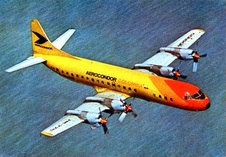 | 98.
The Fabulous Electras 9/2016 The L-188 was a Lockheed design tailored to requirements put forth by American and Eastern Airlines. At the time, (1955) Capital was introducing the Viscount which was clobbering competitive airlines' piston powered flights. Even though deliveries of the Electra would not occur until 1959 most American airlines chose to wait for the Lockheed offering.
It was launched in 1955 with orders for 35 from American and 40 from Eastern, soon followed by most of the other Trunk Lines + PSA.
The early enthusiasm died upon the loss of 3 aircraft to in flight structural failures. The issues were ultimately resolved, but the early surge of orders stopped at 170. Nevertheless the Electra served exceptionally in multiple roles. Many had long second lives as freighters. Now, the few remaining have been reduced to Airsprayers. |
| 9326 Visits
41 Images
Shared Album | |
|
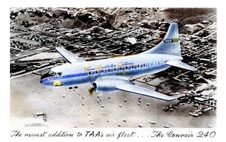 | 99.
Remembering Trans Australia 8/2016 Trans Australia was half of a bizzare twin airline policy in Australia, matching government owned Trans Australia with privately owned Ansett. Both Airlines had a nice postcard history. This is the TAA half.
There is an excellent Trans Australia history site at www.taamuseum.org.au. |
| 6506 Visits
31 Images
Shared Album | |
|
 | 100.
The Air Travel Clubs 7/2016 The bottom rung of the Airline Industry were the Air Travel clubs. Using mostly antique surplus aircraft, they sprang up and blew away like dandelions. Not many lasted long enough to issue postcards, but some were successful, most notably Denver Ports of Call, and Nomads, which only recently perished after many years of successful operations.
Nomads was by far the most prolific issuer of cards, totaling 9 during their long period of service. |
| 9889 Visits
35 Images
Shared Album | |
|
 | 101.
The Super Great DC-8 6/2016 | My Favorite airliner, the nearly indestructible DC-8 filled an assortment of roles, luxury airliner, international charter specialist, and heavy cargoliner, with many in operation long after most 707's were put to rest. These are a few of my favorite DC-8 cards! |
| 10608 Visits
53 Images
Shared Album | |
|
 | 102.
The IAWP Historical Cards 5/2016 | The IAWP historical cards were issued from 1984 - 1995, by Fred Erdman, and each individually numbered. Eschewed by most collectors, and known more for poor printing quality and obscure subjects than historical significance, they nevertheless provide some important images available nowhere else. Included in this set are some of my favorites, with a little history included. |
| 8439 Visits
40 Images
Shared Album | |
|
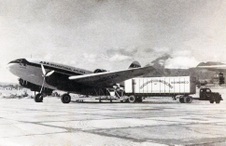 | 103.
Warbirds, The Mighty C-46 4/2016 | The C-46 was the pride of nobody's fleet, but a large number of war survivors populated most non-scheduled airline fleets in the 1950s. Even the American trunk lines found a home for C-46s, mostly as freighters, but a few in passenger service, such as Northeast. A few of these warbirds are still flying today. |
| 5657 Visits
21 Images
Shared Album | |
|
 | 104.
The Local Service Airlines 3/2016 | In order to provide reliable air service to smaller towns the CAB created a category of subsidized airlines. Initially equipped with DC-3s, the 13 Local Service airlines gradually grew into thriving regional, and ultimately major airlines before their consumption by the already bloated trunk airlines. They're all gone now, their initial mission long ago undertaken by the Commuter airlines, and gradually abandoned once again as the "Code Share" commuters grow ever larger. But, the 13 Local Service airlines can be revisited through their legacy of postcards. |
| 17692 Visits
78 Images
Shared Album | |
|
 | 105.
The Super Saabs 2/2016 In 1944 Saab launched an aircraft program that was to be the DC-3 replacement, a short to medium range airliner seating 30 passengers. It was something of a miscalculation, since by the time of its first flight, C-47s were available in large numbers, at a small fraction of the price of a Scandia. Despite a major World wide marketing effort, a total of 18 Saab Scandias were built.
Some 35 years later, Saab launched another airliner which was to have an entirely different result. The Saab 340 was the airliner that was to rescue many small city travelers from the claustrophobic cigar tins that actually had replaced the DC-3. Some 461 were built between 1983 and 1999, and the 340 served with airlines from start ups to the US majors. Most are still flying today. These are some of my favorite Saab cards. |
| 12574 Visits
61 Images
Shared Album | |
|
 | 106.
The 1st Intercontinental Airliner 1/2016 | The Douglas DC-4 spelled the end of long distance Flying Boat operations. With enough range to traverse oceans without getting wet, the DC-4 began the post WW II period of ever more practical international air travel. These are some of the many DC-4 Postcards. |
| 10364 Visits
46 Images
Shared Album | |
|
 |
| |
| 108.
Airline Postcard Collection My complete collection of Airline Postcards. There are 48 sets. Cards are listed alphabetically by Airline. Cards are airline issued unless otherwise noted. Card descriptions with a suffix have been generously contributed by fellow collectors. The suffix codes are as follows, with many thanks to each:
I would very much appreciate scans of Airline issues that I don't have, and would be pleased to provide scans upon request. Questions or comments to dc8schmidt@twc.com |
| 48 Albums
Shared Folder | |
| |